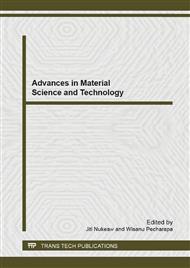p.114
p.119
p.124
p.129
p.134
p.139
p.144
p.149
p.154
Effect of Platinum Substitution on the Microstructures and Dielectric Relaxation of CaCu3Ti4O12 Ceramics
Abstract:
The CaCu3Ti4O12 (CCTO) has the advantage for the various applications especially for capacitive elements in microelectronic devices over the ferroelectric materials including BaTiO3. CCTO is a ceramic compound with a high dielectric constant but it has a high loss tangent at room temperature. In this work, the Influences of PtO2 doping on the dielectric properties of CaCu3Ti4O12 (CCTO) ceramics were investigate. The ceramics CCTO and PtO2 doping CCTO were studied by X- ray diffraction, scanning electron microscopy. The dielectric properties have been measured as a function of temperature and frequency range 0.1 - 500 kHz. The XRD shows the CCTO structure does not changes after doping with platinum. The results show that PtO2 doped can reduce the mean grain sizes of CCTO, but the dielectric constant still remained a height. The samples of 2.0 mol% Pt-doped have exhibited high dielectric constant of about 22,000 and the loss tangent about 0.7 at room temperature and frequency at 10 kHz. The reduced of the loss tangent could be interpreted with the internal barrier layer capacitor model (IBLC)
Info:
Periodical:
Pages:
134-138
Citation:
Online since:
September 2013
Authors:
Keywords:
Price:
Сopyright:
© 2013 Trans Tech Publications Ltd. All Rights Reserved
Share:
Citation:


